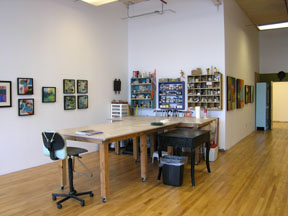How come when I was in art school in the late '80s no one mentioned the name Joan Mitchell? Gender bias - yes, I know. But I remember taking a course in women artists offered in the meager Women's Studies Department at
MassArt, and most of the women we studied had been dead for eons and were either great mistresses or impressionists, neither of which appealed to me particularly. I do recall that Faith Ringold was mentioned in passing, along with Judy Chicago and some other feminist artists, but I don't remember reading about what I would call real painters or seeing their work. I'm talking people (women) who really enjoyed pushing paint around like Joan Snyder, for example, or, since she is my subject - Joan Mitchell.

It's a long time ago and I'm probably forgetting any mention of her when I was in school, but somehow within the past eight years, since I've been living in western Mass., I discovered the work of Joan Mitchell - no thanks to any academics - and became very enthusiastic about it, although without having any desire to paint the way she did. That's probably because I knew I would fail, mostly because her work has a fierce emotional content that I would be incapable of bringing to a painting.

Hudson River Day Line, 1955
I have two large books on her work:
The Paintings of Joan Mitchell by Jane Livingston (catalog of a retrospective Livingston organized at the Whitney in 2002) and
Joan Mitchell * by Klaus Kertess, a longtime friend, gallerist and drinking buddy of Mitchell's. At one time in my old studio in Ashfield, I very much enjoyed paging through these books and wondering how Mitchell had continually composed such intricate paintings over such a long period of time. Her use of color and variety of marks motivated me to pick up the brush and make a painting when I felt overcome by a blank canvas and totally isolated in the wilds of the hilltowns.

Cheim Some Bells, 1964
I came across a review of the Whitney retrospective by Brenda Richardson that was published in
ArtForum in September 2002, and I quote her observations about Mitchell's paintings:
"Mitchell hews to a distinctive palette and personal vocabulary of marks from beginning to end. Green, blue, orange, black, and white are favored colors. Her marks include (1) choppy vertical smears, rather like a color test, usually in pairs, (2) thin "washes" of pastel hues (lime, flesh, rose, slate blue), (3) daubs of impasto, almost always on top of other paint, (4) slashing strokes, long and stiff, vaguely scimitar-like, (5) eroding or "melting" once-geometric rectangles, mounds, or blobs, and (6) drips. Nearly all her paintings use nearly all her colors and all her marks in some combination; the paintings are almost always allover matte in finish (glazed bits appear only occasionally). A painting like Low Water, 1969, is absolutely classic Mitchell, combining all of the above in hieratic descent."

Barge-Peniche, 1975
Mitchell was apparently a "difficult" person (real pain in the ass) who drank way too much, had a long-term love/hate relationship with another painter (Jean-PierreRiopelle), loved dogs, spent most of her adult life in a house on the Seine 30 miles from Paris and made large-scale, many times multi-canvas, paintings continuously for 40 years or so. She was reasonably successful although nowhere near what she would have been if she had only had that other appendage.

After April, Bernie, 1987
Through all the misery and frustrations of her relationships with friends and lovers plus the numerous deaths of friends, relatives and dogs that she suffered and along with her severe health problems and active alcoholism, she kept painting - sometimes raging away at the canvas or expressing less violent emotions that she was unable to release any other way. Her tenacity and commitment to her work despite all this were remarkable, as was her refusal to make paintings in a more manageable size. She must have had a tremendous physical struggle that included having to get a studio assistant to squeeze paint from tubes due to the arthritis in her hands (per Kertess).
She had several cancers at the end of her life, eventually dying of lung cancer in 1992 at age 66. Although suffering excruciating pain, she continued to paint large works until very near her death.

Yves, 1991 (110 1/4" H x 78 3/4"W - that's 12 feet high x 6.5 feet wide)
I have included images of Mitchell's paintings from five decades showing the variety of styles in which she painted. Not included are any of the 21 Grande Vallee' paintings, a series painted over 13 months beginning after the death of her sister in 1982. Painting was an act that allowed Mitchell to transcend death. She said, "Painting is the opposite of death, it permits one to survive, it also permits one to live." (Livingston, p 63)
* Amazon.com lists the Kertess book as only available used from other sellers and starting at $275! I know I didn't pay that shocking price, but it is a great book. Maybe it's available at your art school library - it should be.












































